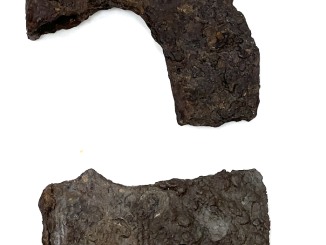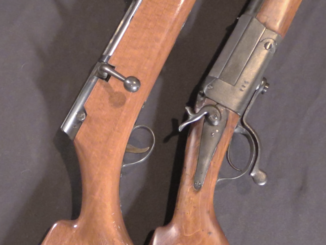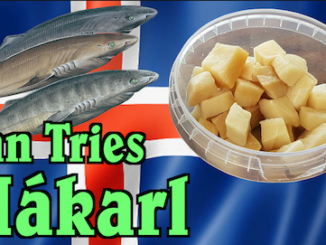(Sorry for the messed-up framing at the beginning of the video!)
While I was in Iceland, I had an opportunity to visit the National Museum of Iceland and take a look at a couple of settlement-era swords found on the island. Since these are really outside my area of expertise, two experts generously offered to join me on the video to help explain the history and context of these swords. First we have Ármann Guðmundsson, an archaeologist with the Museum who can speak to the weapons of the time as they are found today. Second is Reynir Óskarsson, a Viking combat researcher with Hurstwic who can help us understand how these swords were actually used.
Viking-age Iceland was a unique society in many ways, and the role of personal weapons in that time is a fascinating story. So sit back and join us to learn more about it!
Many thanks to the National Museum of Iceland for bringing out these incredible thousand-year-old artifacts to show us. If you are in Reykjavik the Museum are a must-see stop:
https://www.thjodminjasafn.is/english/




Very good topic and they both had impressive English skills as well.
That was lovely! I enjoyed it very much.
You’re right – it is Forgotten Weapons, not guns.
I look forward to future video on ballistas 🙂
Just a few points dredged up from my memory.
The most standardized typology for pre-Millenial European (including Scandinavian) swords is the Petersen typology;
http://www.vikingage.org/wiki/wiki/Swords
Later, the Oakeshott typology took in “medieval” swords;
https://albion-swords.com/articles/oakeshott-typology.htm
Basically, “Medieval” swords are more-or-less direct descendants of Viking swords, just generally with longer blades required for fighting from horseback. (I.e., you had to be able to reach the guy on the ground to hit him.) All of them were designed for “slashing”; nobody much before the 16th century figured out the whole “thrusting” thing.
The lower survival rate of Icelandic swords is mostly due to the soil. Norway had soil with peat bogs and etc, which meant that burial “grave goods” had a better chance of not rotting or corroding away due to the anaerobic nature of the soil.
Icelandic soil is largely volcanic in nature. This meant that Iceland actually got richer after about the early 14th Century, because when European kings needed black powder to fight their wars, Iceland was Northwestern Europe’s main source of both sulfur and saltpeter (calcium nitrate that could be processed into potassium nitrate, KNO3).
However, this also meant that the soil was generally acidic. And iron artifacts tended to be “eaten” by the combination of sulfur and water from hot springs, resulting in H2SO4- sulfuric acid.
Swords, like axes and etc., back then were generally made from “bog iron”. Steel was pretty much unknown. The usual method of making a sword, or an ax, was to forge the blade mostly from relatively soft iron (to prevent it breaking), then insert a hardened iron “wedge” for the actual cutting edge. The same technique is seen in very early Japanese swords, as well as daggers.
BTW, the Viking ax was not the double-bitted twenty-five pound monster beloved of Hollywood and fantasy RPGs. (Role-Playing Games, not Rocket-Propelled Grenades, folks.) It was a simple, single-bit woodcutter’s axe with a helve maybe 90cm (about three feet) long, and weighing at most about 1.5 kg (about three pounds). It was much lighter and thinner-bladed than what we think of as a woodsman’s ax today, because our modern axes evolved to cut the heavy woods like oak and walnut in the New World; the Viking axes only had to deal with lighter woods.
What this meant was that in a fight, the Viking ax could be swung for a long time without tiring yourself out. What armor there was back then was mostly leather and didn’t offer much resistance to an ax blade. It could also thrown like a hatchet, and often was, before the warrior drew his blade and got down to business.
Speaking of blades, the “scramasax” was probably more common than the sword;
https://irongatearmory.com/product/scramasax/
At about 40-50 cm OAL and weighing about half a kilogram (i.e about 16-17 inches and maybe a pound weight), it was as much a utility tool as a weapon; the Bowie knife of its day. And yes, as shown here, women carried them too.
At least one medieval pole arm, the glaive, apparently began when some bright boy thought “Hey, what if I put a scramasax blade on a ten-foot-long pole?” It and its first cousin, the English bill, both apparently began more or less like this.
The survival rate of axes, glaives, bills and scramasaxes is fairly low. Mostly because being as much utility tools as weapons (the bill and glaive were great for harvesting apples and pears off trees), most of them were worn out “on the farm” and ended up as scrap reprocessed into something else. Iron, like any metal, is “fungible”, i.e., you can melt it down and make something else out of it.
So yes, your great-grandpa’s iron pot-bellied stove might once have fought at Bosworth Field.
😉
cheers
eon
With the caveat that there isn’t a thing like a “Viking sword” as a distinguished pattern or style. Despite the common naming, those were really “Viking era swords”, for the areas of Europe where the Viking raids had some importance.
The medieval European center of production of blades, from where enough blades were made to be exported, had always been located in Germany-France-Northern Italy.
Then there were then other, locals, centers of productions, that covered the local demand. Often copying patterns coming from the main one.
Viking swords had nothing that made them “Viking” in respect to blades made in the main production area. Many of them were made there and imported in Scandinavia infact.
Interesting…
“The German slashes, the Frenchman thrusts.”
Quote from “Minna von Barnhelm”, written by Gotthold Ephraim Lessing in 1767.
The Prussian nobility fought duels for the scars and the honor they thought went with them.
Most everybody else understood that the whole point was to put the other guy down as fast as possible.
Or as Donald Hamilton once said, “There isn’t much ‘honor’ in a ‘scar’ that goes in the front and comes out the back“.
cheers
eon
I read a book “A Novel” called the Greenlanders; https://en.m.wikipedia.org/wiki/The_Greenlanders
“I used to rack up big phone bills to my parents crank, calling Greenland” – Hallo? Hee!! Oh I did giggle, snowmen. Anyway I have been interested in Greenland/Iceland since about 1990; so I know a fair abit about it. The book, it must be said is a bit bleak… Overall. It is a good narrative, puts you into the time. It suggests iron… Swords etc, well by the late 14th c Simply rusted away etc and weren’t replaced; with… Well unfortunate results – Folk who had swords etc from the Basques/Bristol England. Might be some more known truth in the Basques as Iceland only said if you get any washed up don’t kill them (As oppose do) a few years ago, might be connected. The book was bleak showed the church, sort of… Well similar to Europe, certainly happened in Iceland; burning Nuns – You know paranoid religous dribble, from unenlighted folk… Really took its toll, on the Viking relatives in Greenland.
I think what I mean is, the book was very good at illustrating why religion limited scientific etc progress for hundreds and hundreds of years.
I think that prespective on religion limited a scientific outlook is bit limited. The Christian church play a major role in creating schools and educating people. To be able to read the bible was one of the goals of the church. In many languages the first book was the bible.
Fair point, I thought that; but it was an interesting “Other view” after I suppose it had been around for awhile, and sort of made the situation of makind a bit “Stagnant” in the context of the book, it was apparent that the suggestion was undermined the already old by then Viking culture – Which was not handy, vs Violent Pirates; who may have been born Christian but weren’t very nice.